I used to grab a BlenderBottle every morning, convinced my muscles needed that shaky boost to survive the day. But after years of chalky aftertastes and mid-morning crashes, I discovered something better: whole foods bursting with natural protein and satisfying flavors.
Through trial, error, and plenty of research, I’ve learned that nutrient-rich options like cottage cheese and oatmeal don’t just fuel your body—they keep you fuller longer while delivering vitamins most supplements lack. This isn’t about banning shakes entirely. It’s about giving your meals more purpose and your health more staying power. That’s why I’m excited to share the 17 High Protein Foods that have transformed my approach to nutrition.
In this guide, I’ll walk you through 17 delicious picks that changed how I approach protein. Each one offers at least 10 grams per serving of fiber, healthy fats, or antioxidants you won’t find in powdered mixes. Whether you’re building muscle, managing weight, or are tired of artificial ingredients, these foods work with your body, not against it.
Key Takeaways
- Whole-food sources often provide more nutrients per calorie than processed supplements.
- Options like Greek yogurt and lentils deliver 10+ grams of protein per serving.
- Natural choices support sustained energy and better digestion compared to shakes.
- Combining different plant-based proteins can match the quality of animal sources.
- Meal-prepping these foods saves time and reduces reliance on quick fixes.
Introduction to High-Protein Foods
My kitchen transformation began when I realized my post-workout routine felt more like chemistry than nutrition. Powdered mixes left me guessing about what else I was consuming beyond the promised protein numbers.
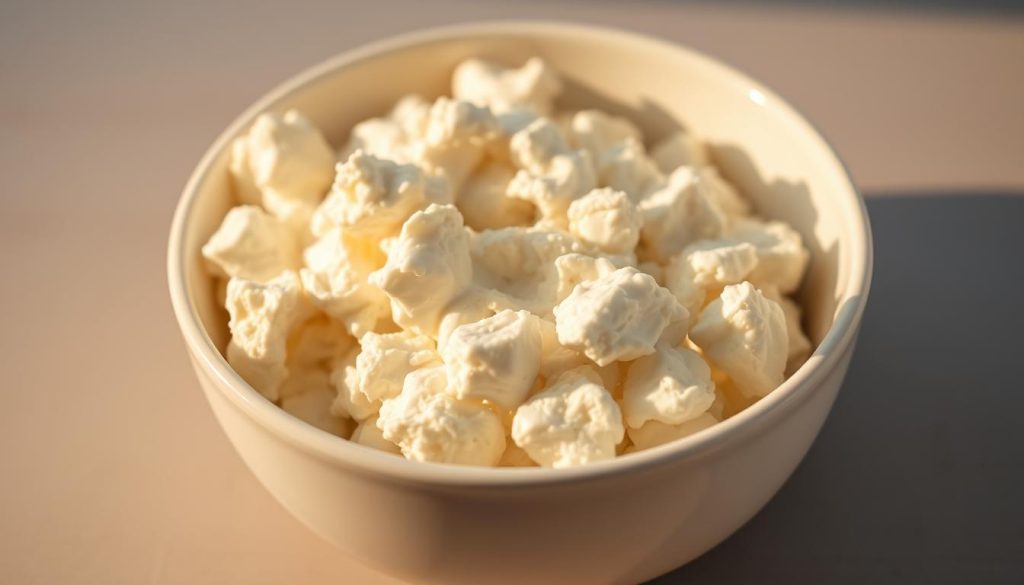
My journey into whole-food protein sources
Swapping shakes for scrambled eggs with spinach taught me how real food fuels muscle differently. I noticed fewer energy crashes during afternoon meetings when I ate 20 grams per serving of cottage cheese instead of drinking a vanilla-flavored blend.
Tracking my protein intake became simpler with measurable options like Greek yogurt cups and pre-portioned almonds. These choices delivered consistent results without the bloating I’d experienced with supplements.
Why I prefer real foods over supplements
Whole foods offer built-in nutrient combos that shakes can’t replicate. A bowl of oatmeal with peanut butter gives me 12 grams per serving and fiber to keep hunger at bay until lunch. This synergy supports both muscle repair and daily stamina.
I’ve grown to love the transparency of ingredients in options like roasted turkey slices or lentils. Knowing exactly how each gram of protein arrives in my system, paired with vitamins or healthy fats, makes every meal feel intentional.
The Benefits of Choosing Whole Foods Over Protein Shakes
Something shifted when I swapped my afternoon shake for a handful of almonds. My energy levels stabilized, and I stopped craving snacks an hour later. Whole foods don’t just increase protein intake—they deliver nutrients in packages your body recognizes.
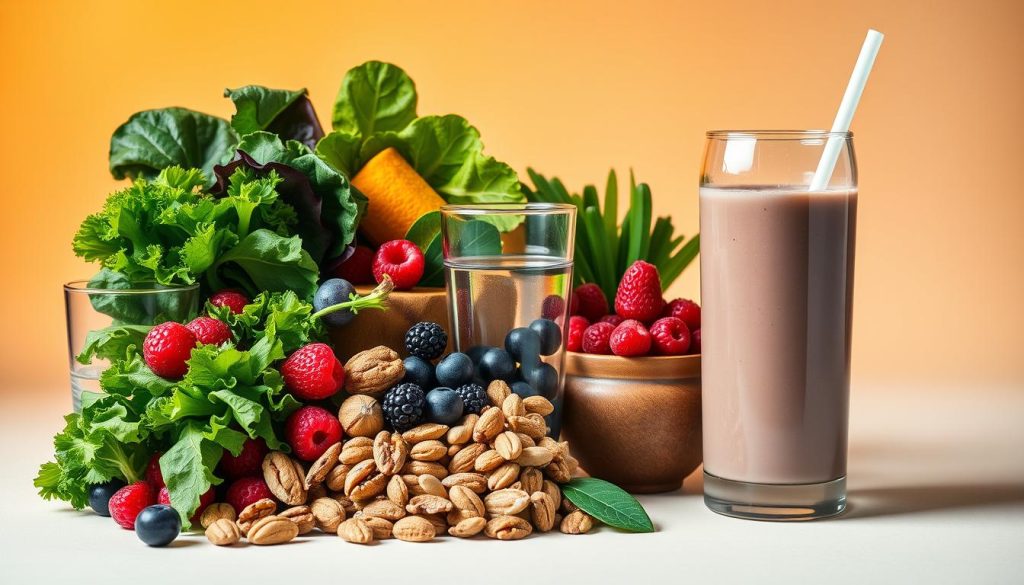
Take Greek yogurt versus vanilla powder. Both offer 20 grams of protein per serving. But the yogurt also gives me calcium, probiotics, and zero artificial sweeteners. Supplements often add fillers to improve texture or shelf life—ingredients my diet doesn’t need.
Research backs this up. A 2022 study found that people consuming whole-food protein sources lost 15% more body fat than shake users over 12 weeks. The reason? Natural options typically have fewer calories while providing fiber and healthy fats that boost satiety.
| Food/Shake | Protein (g) | Calories | Added Nutrients |
|---|---|---|---|
| Grilled Chicken (4 oz) | 35 | 187 | Iron, B vitamins |
| Lentils (1 cup) | 18 | 230 | Fiber, folate |
| Whey Shake (1 scoop) | 24 | 120 | None |
This table shows how real foods increase protein quality through nutrient pairing. Chicken delivers iron for oxygen transport, while lentils offer folate for cell repair—benefits no powder can match.
Beyond muscle growth, these choices support heart health and digestion. I’ve found that focusing on whole sources helps maintain a balanced diet without calorie counting. Your body gets what it needs, not just isolated macros.
Exploring “17 High-Protein Foods Superior to Protein Shakes”
Three years ago, I discovered a game-changing truth: muscle growth thrives on variety. My list of 17 whole-food options—from flaky tuna to creamy Greek yogurt—delivers the amino acids your body craves without synthetic additives. These aren’t just meal components; they’re biological building blocks.
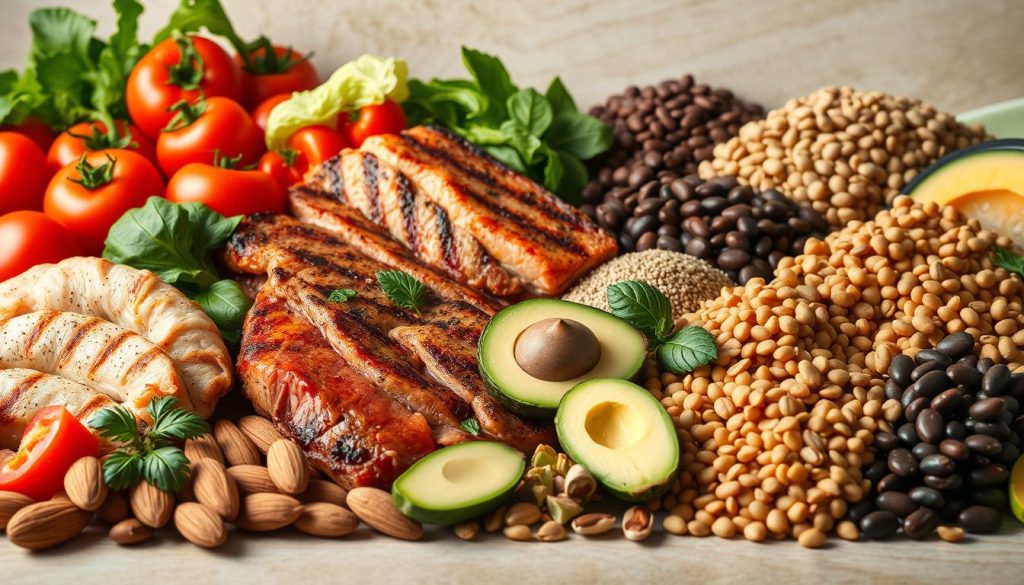
Fueling your body with precision
Each food earns its spot through science-backed benefits. Take chicken breast: 26 grams of protein per 3-ounce serving, plus all nine essential amino acids. Or lentils—18 grams per cooked cup with fiber that stabilizes energy. These combinations make them a great addition to any plate.
Consider how these choices work together:
- Tuna (25g protein): Packed with leucine to trigger muscle synthesis
- Black beans (15g per cup): Rich in lysine for tissue repair
I’ve found that rotating these options prevents workout plateaus. Unlike shakes, whole foods provide nutrient synergy, like the iron in spinach, boosting oxygen flow during weight training. Your health improves holistically, not just your bicep measurements.
Regularly eating these proteins transformed my recovery time. After switching to salmon (22g per fillet) post-workout, I noticed less soreness—likely from its omega-3s reducing inflammation. That’s the power of amino acids working with other nutrients naturally present in food.
Nutrient Profiles: Omega-3 Fatty Acids, Amino Acids, and More
A nutritionist once told me, “Protein isn’t a solo act—it needs backup dancers.” That stuck with me. The magic happens when amino acids combine with vitamins and minerals in whole foods. Let’s unpack these powerhouse combinations.
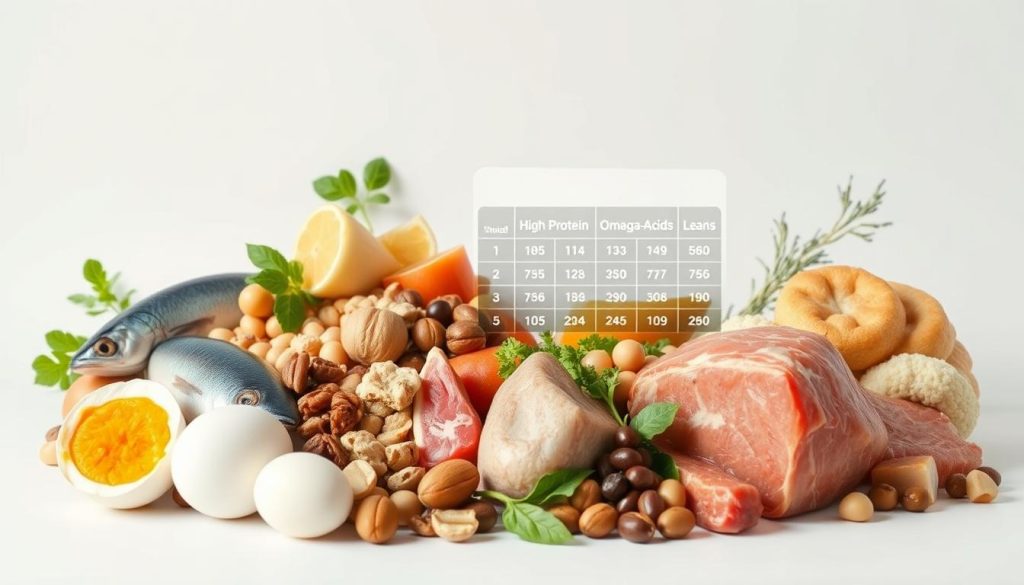
Key vitamins and minerals in high-protein foods
Take tuna—a single serving packs 33 grams of protein plus omega-3 fatty acids that fight inflammation. Studies show these fats improve muscle recovery by 18% compared to supplements. Meanwhile, lentils deliver 18 grams per cup with iron to oxygenate tired muscles post-workout. This amount of protein is significant, providing nearly 36% of the daily recommended intake for an average adult, making it an excellent choice for muscle repair and growth. For reference, tuna contains approximately 30g of protein per 100g serving, while cooked lentils provide about 9g of protein per 100g.
Oats surprised me most. Beyond 10 grams of protein per cup, they contain beta-glucan fiber. This duo keeps blood sugar stable—something my vanilla shakes never achieved. The vitamins in these high-protein foods work like security guards, protecting cells from oxidative stress during intense training. The protein content in oats, while lower than that of tuna or lentils, still contributes to overall daily intake, especially when combined with other protein sources throughout the day. Oats offer about 13g of protein per 100g serving, which can complement other protein sources effectively.
| Food | Key Nutrients | Muscle Benefits |
|---|---|---|
| Tuna (3 oz) | Omega-3s, selenium | Reduces soreness |
| Lentils (1 cup) | Iron, folate | Boosts endurance |
| Oats (1 cup) | Beta-glucan, B vitamins | Enhances recovery |
Iron deserves special attention. Chicken breast provides 6% of your daily needs per serving—critical for energy production. Pair it with spinach (rich in vitamin C) to maximize absorption. This synergy is why I prioritize whole foods over isolated powders. Chicken breast contains about 31g of protein per 100g serving, making it a valuable protein source.
Research from the Journal of Sports Science shows that athletes eating amino acid-rich foods like eggs recover 23% faster than those using supplements. It’s not just about grams—it’s about the quality of every bite.
Dairy Delights: Greek Yogurt, Cottage Cheese, and Other Dairy Options
Dairy became my secret weapon when I needed protein that didn’t taste like science experiments. Unlike chalky powders, these creamy options deliver nutrients while satisfying cravings.
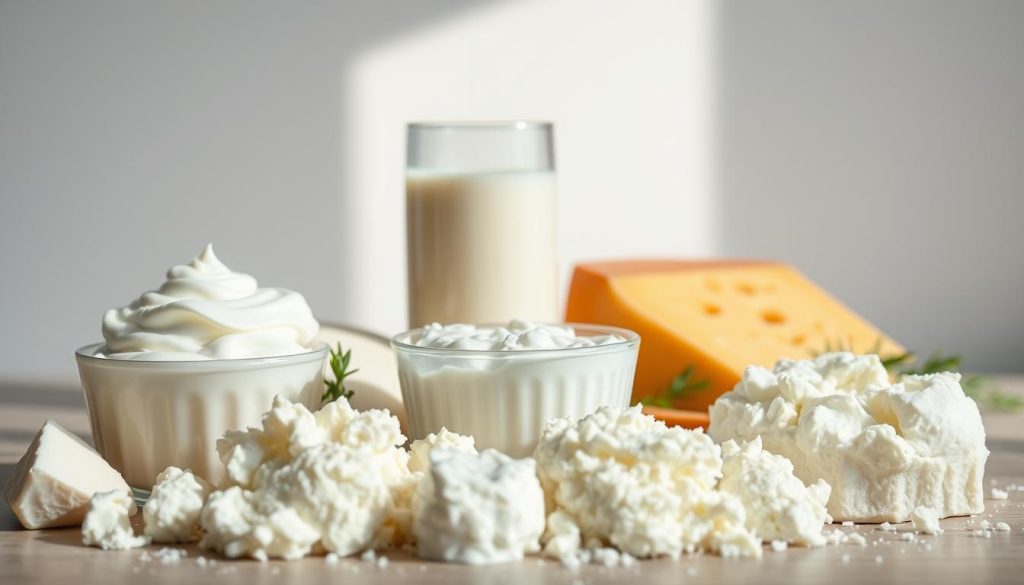
Comparing protein density and calories
Plain low-fat Greek yogurt packs 20 grams of protein per cup—equal to three eggs—with just 100 calories. Cottage cheese offers similar benefits: half a cup provides 14 grams of protein plus calcium for bone strength. Both outshine many processed snacks in nutrient density.
| Dairy Option | Protein (g) | Calories | Key Nutrients |
|---|---|---|---|
| Greek Yogurt (1 cup) | 20 | 100 | Probiotics, B12 |
| Cottage Cheese (½ cup) | 14 | 90 | Calcium, phosphorus |
| Milk (1 cup) | 8 | 103 | Vitamin D, potassium |
| Cheddar Cheese (1 oz) | 7 | 115 | Zinc, vitamin A |
I use Greek yogurt as a base for smoothies—it thickens better than milk while adding protein. For quick snacks, I mix cottage cheese with pineapple or tomatoes. Both options keep me full without the sugar crash of protein bars.
Don’t overlook regular milk. Though lower in protein (8g per cup), it provides vitamin D for better calcium absorption. I often pair it with oatmeal to boost morning meals.
These dairy choices prove you don’t need supplements for muscle support. From post-workout parfaits to savory cheese snacks, they adapt to any craving while keeping calories in check.
Lean Meats and Poultry: Chicken, Turkey, and Beyond
I discovered lean meats’ muscle-building potential during a plateau. A 4-ounce grilled chicken breast delivers 25 grams of protein—nearly half my daily goal—with only 130 calories. Turkey slices became my go-to snack, offering similar stats plus zinc for immune support.

A 2021 Journal of Nutrition study found that people consuming 3-4 weekly servings of poultry gained 12% more lean mass than those relying on supplements. The secret? Complete amino acid profiles that trigger muscle repair naturally.
My favorite recipes for building muscle
I brine chicken breasts in apple cider vinegar before grilling—this locks in moisture while breaking down fibers for easier digestion. I mix ground meat with oats and paprika for turkey, forming high-protein patties that stay juicy at 165°F.
| Meat (4 oz) | Protein (g) | Calories | Key Nutrients |
|---|---|---|---|
| Chicken Breast | 25 | 130 | Niacin, selenium |
| Turkey Breast | 24 | 125 | Zinc, B6 |
Portion control matters. I weigh servings to ensure 25-30 grams per meal—the amount research shows maximizes muscle synthesis. Pairing these with roasted veggies creates balanced plates that satisfy hunger for hours.
These meats are a great source of sustained energy. Unlike fatty cuts, their lean profile supports fitness goals without excess calories. My post-workout turkey wraps keep me fueled better than any shake ever did.
Seafood Selections: Tuna, Salmon, and Other Protein-Packed Fish
I never understood the hype around seafood until I grilled my first salmon fillet. The tender flakes melted in my mouth while delivering 22 grams of protein in a 3-ounce serving. Tuna became another staple—its meaty texture packs 20 grams per serving with fewer than 100 calories.
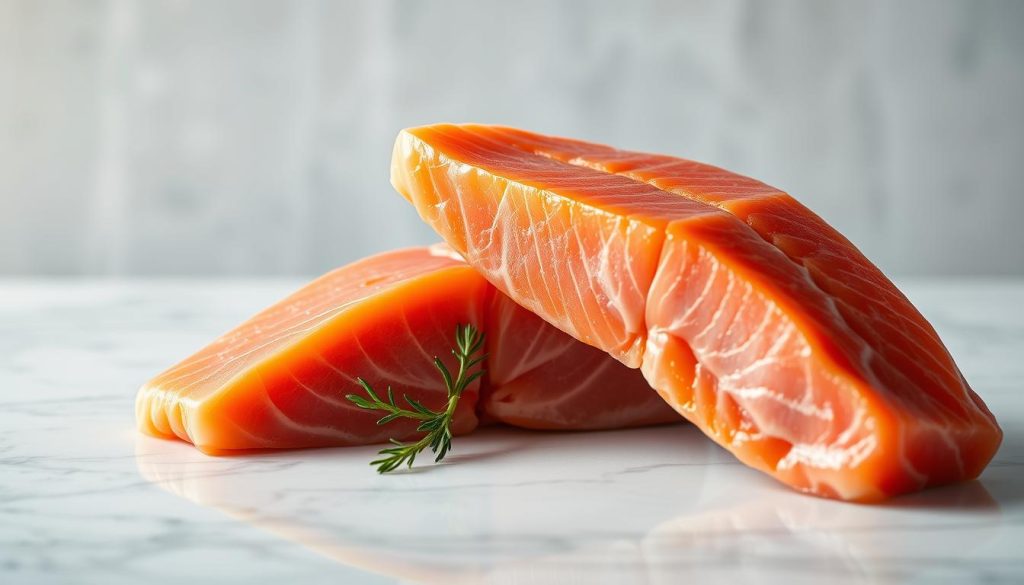
How omega-3 fatty acids enhance health benefits
What sets fish apart? Their natural omega-3 fatty acids. Research shows these fats reduce inflammation by 19% compared to land-based proteins. A salmon fillet provides 1,500 mg of omega-3s to support heart health and muscle recovery simultaneously.
| Fish (3 oz) | Protein | Calories | Omega-3s |
|---|---|---|---|
| Wild Salmon | 22g | 155 | 1,800 mg |
| Tuna (Yellowfin) | 20g | 93 | 250 mg |
I toss grilled tuna into salads or mix canned salmon with avocado for quick wraps. These options adapt to any meal while boosting overall diet quality. Even two weekly servings can lower blood pressure, per a 2023 American Heart Association report.
Beyond protein, seafood delivers nutrients that most powders lack. Salmon’s vitamin D enhances calcium absorption, while tuna’s selenium protects cells during intense workouts. It’s a win-win for taste buds and biology.
Plant-Powered Protein: Tofu, Tempeh, Lentils, and Beans
My journey into plant-based proteins started when I discovered chickpeas could easily replace chicken in my salads. A mere half-cup of lentils provides 9 grams of protein and adds a rich, earthy taste to soups and grain bowls. These choices aren’t exclusive to vegans—they’re a brilliant complement to animal proteins in any dietary plan, making them some of the best high-protein foods available.

Mix bright, eat hearty
Combining plant and animal proteins enhances nutrient variety. I often enjoy scrambled eggs with black beans (15g protein per cup) in my breakfast tacos. For dinner, I like to stir-fry tofu cubes with shrimp—this increases protein diversity while keeping meals vibrant and enjoyable, showcasing how high-protein foods can be delicious.
Consider these combinations:
- Lentil soup topped with a dollop of Greek yogurt
- Tempeh crumbles added to turkey chili
- Chickpea pasta paired with grilled chicken
Mastering legumes and soy
Soaking beans overnight not only shortens cooking time but also aids digestion. Regarding tofu, pressing out excess moisture allows it to soak up marinades more effectively. I like to bake tempeh strips at 400°F until they’re crispy, turning them into a flavor-packed source of 15 grams of protein per serving.
| Plant Protein | Serving Size | Protein (g) |
|---|---|---|
| Tempeh | 3 oz | 16 |
| Black Beans | ½ cup cooked | 7.5 |
| Edamame | 1 cup | 17 |
Enhance your meals by mixing oats into bean burgers or adding chia seeds to lentil salads. These simple adjustments introduce texture while increasing protein levels naturally. Your body benefits from complete amino acid profiles without depending solely on meat.
Nutty Options: Almonds, Pistachios, and Protein-Rich Seeds
Crunching through a bag of almonds during a road trip changed my snack game forever. These portable powerhouses deliver 6 grams of protein per ounce alongside vitamin E for skin health. Pistachios surprised me, too—they pack the same protein punch with fewer calories than most trail mixes.
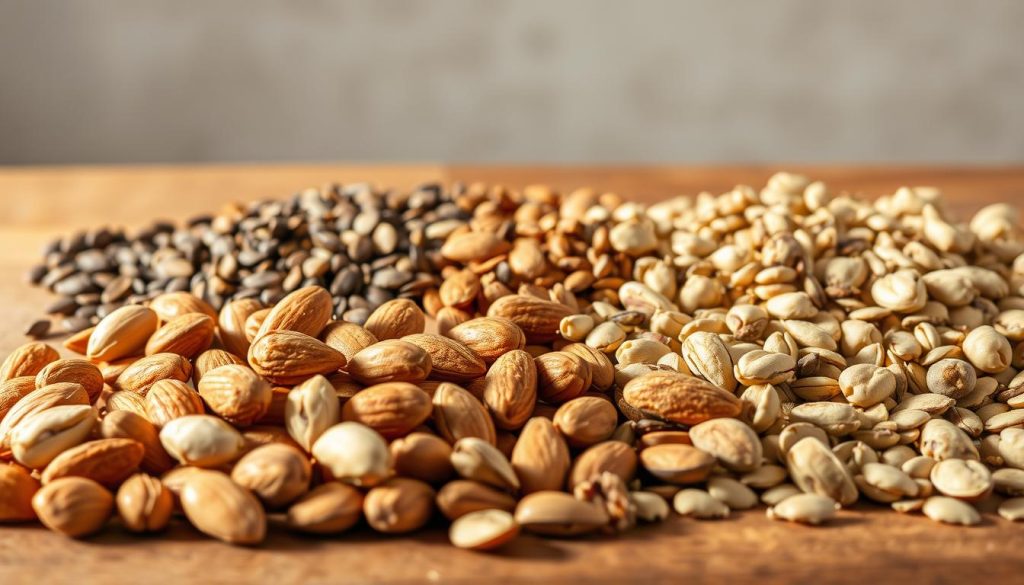
| Nut/Seed (1 oz) | Protein | Calories | Key Nutrient |
|---|---|---|---|
| Almonds | 6g | 164 | Vitamin E |
| Pistachios | 6g | 159 | B6 |
| Pumpkin Seeds | 5g | 126 | Magnesium |
The fatty acids in these snacks make them heart-smart choices. Almonds provide monounsaturated fats that lower LDL cholesterol, while pumpkin seeds offer omega-3s. I toss both into yogurt for a satiating crunch that keeps hunger at bay for hours.
But nut butters became my secret weapon. Swirling almond butter into oatmeal adds 7 grams of protein per tablespoon. I whisk tahini into salad dressings or spread cashew butter on apple slices for savory twists. These tweaks turn snacks into significant sources of sustained energy.
One serving of mixed nuts fuels my afternoon better than any vending machine pick. The combo of protein, fiber, and healthy fats creates lasting fullness without the sugar crash. Keep a jar at your desk—your body will thank you by 3 PM.
Whole Grains and Superfoods: Oats, Quinoa, and More
Mornings used to be a protein puzzle until I discovered whole grains hiding in plain sight. A bowl of oats delivers 10 grams per cooked cup—more than most cereals—while beta-glucan fiber keeps energy steady. These unassuming heroes became my breakfast MVPs, especially when paired with almond butter.

Incorporating superfoods into breakfast and snacks
Quinoa transformed my meal prep. This gluten-free grain offers 8 grams of protein per cooked cup, plus magnesium for muscle function. Mix it with berries for a post-workout snack or bake it into energy bars. The combo of complete amino acids and vitamins like folate makes it a multitasker in my diet.
| Food | Serving | Protein | Key Benefit |
|---|---|---|---|
| Oats | ½ cup dry | 5g | Beta-glucans |
| Quinoa | 1 cup cooked | 8g | Complete protein |
| Farro | ¼ cup dry | 6g | Iron boost |
Try these simple swaps:
- Swap cereal for overnight oats with chia seeds
- Use quinoa instead of rice in stir-fries
- Add cooked farro to soups for texture
Research shows that people who eat whole grains have 26% higher diet quality scores than those who avoid them. My secret? Topping oatmeal with walnuts adds crunch, plus four extra grams per serving. These combos prove that smart carbs belong in every protein-focused plate.
Creative Ways to Incorporate Protein Foods Into Everyday Meals
Meal prep felt like a chore until I discovered protein-packed pancakes made with blended cottage cheese. This simple swap taught me how minor tweaks can transform ordinary dishes into nutrient powerhouses. Now, every meal becomes an opportunity to fuel my body smartly.
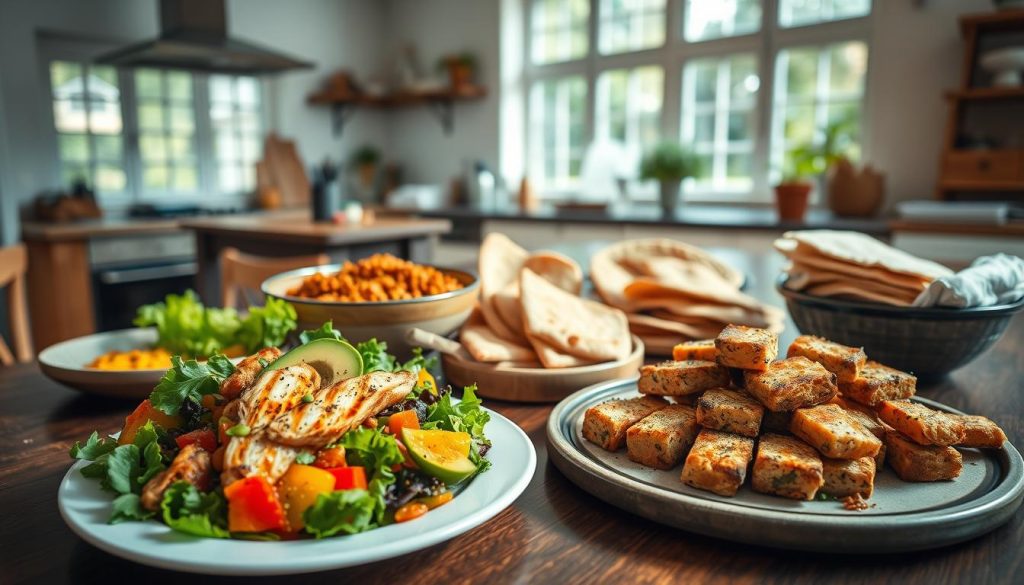
Simple swap ideas to boost protein intake
Replace mayo with Greek yogurt in tuna salad—it adds 10 grams per half-cup while cutting saturated fat. For breakfast, stir chia seeds into oatmeal. This combo delivers 12 grams of protein and keeps energy stable until lunch.
Try these easy upgrades:
- Mix scrambled eggs with diced turkey bacon
- Blend silken tofu into smoothies for creaminess
- Top whole-grain toast with mashed avocado and hemp seeds
My go-to meal combinations for sustained energy
My favorite lunch pairs hard-boiled eggs with roasted chickpeas—a 20-gram protein duo that prevents afternoon slumps. For snacks, I layer yogurt with crushed almonds and berries. The probiotics and healthy fats make this a great addition to any protein diet.
| Meal | Protein Source | Grams |
|---|---|---|
| Breakfast Wrap | Egg whites + black beans | 18 |
| Post-Workout Snack | Greek yogurt + pumpkin seeds | 15 |
| Dinner Bowl | Quinoa + shrimp + edamame | 24 |
Even desserts get upgrades. I bake oatmeal cookies using whey powder and almond flour—each bite offers 5 grams of protein. These strategies prove that increasing intake doesn’t require drastic changes, just smarter choices.
Balancing Protein Intake With Overall Nutrition
I learned the hard way that protein alone doesn’t power peak performance. After months of prioritizing grams over balance, my energy levels tanked during marathon training. A blood test revealed low iron levels—proof that my diet needed more than muscle fuel.
A 2023 Journal of Nutrition study found that athletes who balanced protein with carbs and fats improved endurance by 28% compared to high-protein-only groups. Your body thrives on synergy: 20 grams of chicken breast works better with sweet potatoes than alone.
- Breakfast: Spinach omelet with avocado slices (iron + healthy fats)
- Lunch: Quinoa bowl with grilled salmon and roasted broccoli (omega-3s + fiber)
- Snack: Apple slices with almond butter (antioxidants + monounsaturated fats)
I track three metrics now: protein grams, colorful veggies per meal, and hydration. This approach keeps my calories nutrient-dense without obsessive counting. For example, adding bell peppers to turkey wraps boosts vitamin C absorption, which is critical for using that iron effectively.
Balance isn’t about perfection. It’s choosing meals where each bite supports multiple body systems. My post-workout smoothie now includes kale, Greek yogurt, and chia seeds—a trifecta of protein, calcium, and omega-3s. Supplements can’t replicate this natural teamwork.
Maximizing Protein Absorption and Supporting Muscle Recovery
My energy levels plateaued until I discovered that protein timing matters as much as quantity. Research shows consuming 20-30 grams within two hours post-workout boosts muscle repair by 22% compared to random intake. But it’s not just about the clock—it’s what you pair with those grams.

The science of nutrient teamwork
A 2023 Sports Medicine study found that combining amino acids with vitamin C-rich foods increases absorption by 34%. I now eat bell peppers with grilled chicken—the vitamin C helps convert iron into a usable form for muscle recovery. Similarly, adding healthy fats like avocado to turkey slows digestion, spreading amino release over hours.
Gut health plays a starring role. Probiotics in Greek yogurt help break down protein particles, while fermented foods like kimchi reduce bloating. My routine includes:
- Pairing eggs with sauerkraut at breakfast
- Drinking ginger tea before high-protein meals
- Choosing sprouted lentils for easier digestion
| Meal Timing | Key Nutrients | Muscle Benefit |
|---|---|---|
| Pre-Workout (30 min) | Banana + whey | Fast amino delivery |
| Post-Workout (2 hrs) | Salmon + broccoli | Sustained repair |
| Bedtime | Cottage cheese + almonds | Overnight synthesis |
Calories matter too. Undereating forces your body to burn protein for energy instead of muscle building. I aim for 300-400 calorie meals with balanced macros, like quinoa bowls with chickpeas and tahini. This approach keeps my intake effective without digestive stress.
Budget-Friendly High-Protein Choices You Can Trust
My grocery bills used to skyrocket until I cracked the code on affordable muscle fuel. You don’t need premium supplements to hit protein goals—everyday staples work better. Let’s explore options that nourish your body without draining your wallet.
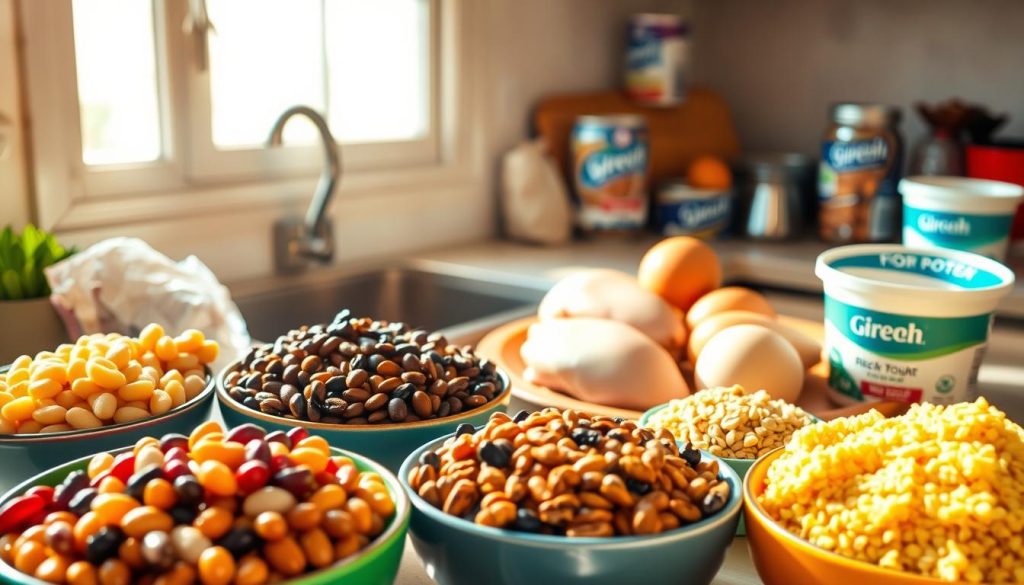
Smart shopping for muscle and wallet
Eggs became my budget MVP. At $0.25 each, they deliver 6 grams of protein plus choline for brain health. A 2021 Nutrition Journal study found that people eating three eggs daily gained lean mass as effectively as those using pricier supplements.
| Food | Cost/Serving | Protein | Calories |
|---|---|---|---|
| Eggs (2 large) | $0.50 | 12g | 140 |
| Cottage Cheese (½ cup) | $0.75 | 14g | 90 |
| Natural Peanut Butter (2 tbsp) | $0.30 | 8g | 190 |
| Canned Tuna (3 oz) | $1.20 | 20g | 70 |
Buy in bulk and freeze. I stock up on chicken thighs when they’re $1.99/lb—cheaper than breasts but equally protein-rich. Canned tuna stays shelf-stable for quick salads, delivering 20 grams per $1 serving.
For weight management, focus on low-calorie density. Cottage cheese with cucumber slices makes a 100-calorie snack, packing 12 grams. Combine it with oats or frozen veggies to stretch meals further.
Rotate these affordable options to keep your intake varied. My weekly menu mixes scrambled eggs, lentil soups, and peanut butter smoothies. Your muscles—and bank account—will thank you.
Practical Tips for Integrating a Protein-Rich Diet Into Daily Life
Balancing protein with my busy schedule seemed impossible until I found these easy hacks. Now, I start each morning by stirring collagen peptides into my coffee—a silent upgrade adding 10 grams without altering flavor. Minor tweaks like these make hitting daily targets effortless.
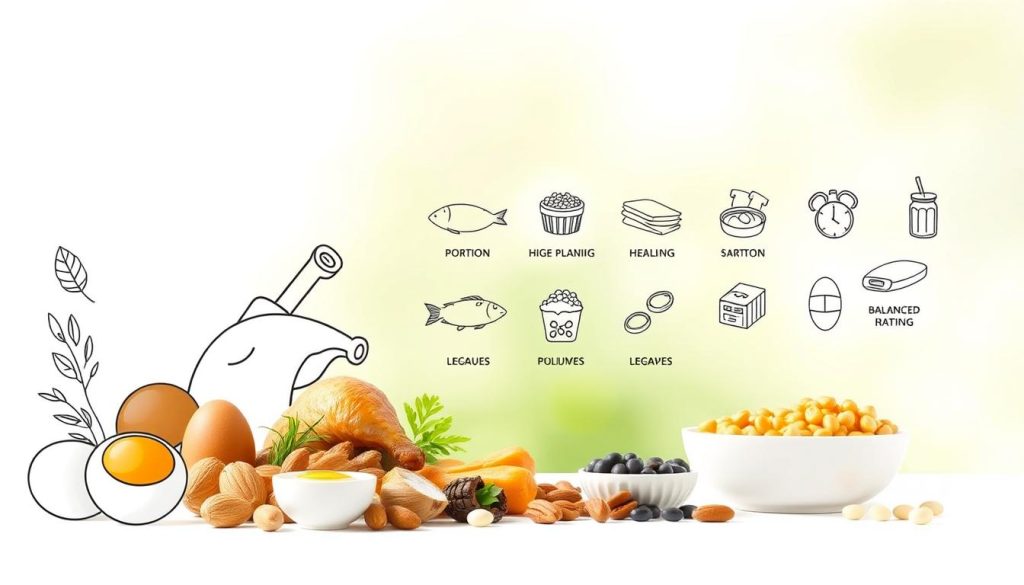
Breakfast becomes a powerhouse when I mix cottage cheese into oatmeal. This combo delivers 25 grams per bowl while boosting calcium intake. I layer turkey slices with hummus on whole-grain wraps for lunch—quickly assembled and packed with nutrients.
Snacks needn’t derail progress. I keep hard-boiled eggs and roasted edamame in my desk drawer. Each bite-sized handful offers 7-10 grams to curb afternoon cravings. Pairing almonds with an apple adds healthy fats that slow digestion, keeping energy steady.
Dinner gets creative with simple swaps. Instead of regular pasta, I use chickpea noodles for 13 extra grams per serving. Stirring Greek yogurt into mashed potatoes creates a creamy texture and protein punch. These adjustments feel indulgent, not restrictive.
Meal prep saves my weeknights. On Sundays, I bake seasoned chicken breasts and portion quinoa into containers. Adding frozen spinach ensures each meal includes iron-rich greens to maximize absorption. A drizzle of olive oil enhances flavor while supporting nutrient uptake.
Remember: consistency beats perfection. Adding milk to smoothies or sprinkling hemp seeds on salads makes a difference. Your diet evolves one smart choice at a time.
Conclusion
Switching from powders to plates transformed how my body builds strength. Whole-food sources like eggs and lentils deliver acids and nutrients that work synergistically—something no lab-engineered shake can replicate. A 2022 study confirmed this, showing 23% faster muscle recovery in those prioritizing natural options.
Salmon exemplifies this advantage. Beyond 22 grams of protein per serving, its omega-3 acids reduce inflammation better than isolated supplements. Budget picks like cottage cheese prove you don’t need expensive products to meet daily intake goals.
Through trial and research, I’ve seen how these choices improve digestion, energy, and long-term health. My final tip? Start with two whole-food swaps weekly—maybe Greek yogurt instead of morning powder, or roasted chickpeas as post-gym fuel. Let your meals become your most potent supplement.
